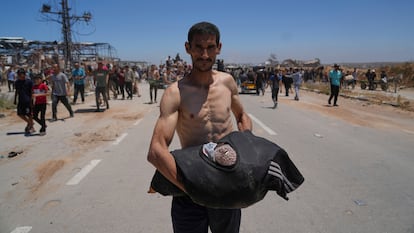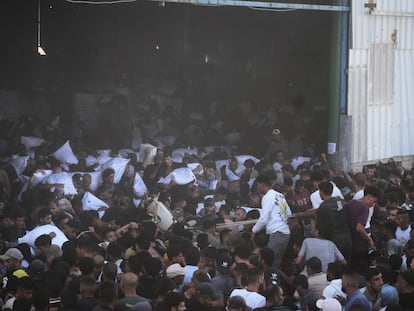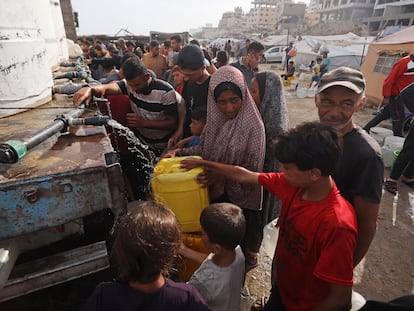Israel forces thousands of Gazans to travel tens of miles to access aid
Three of the four distribution points run by the private foundation operating outside the UN system are located in the south — precisely where Netanyahu has been attempting for months to displace the population in order to ‘conquer Gaza’


If starving Gazans want food, they must travel to the southern part of the Gaza Strip. There, between the sea and militarized areas, the Israeli government has positioned three of the four food distribution points of the Gaza Humanitarian Fund (GHF), a private, shadowy entity backed by the United States. The fourth is located in the center of the enclave.
The location is no accident, according to U.N. allegations, corresponds to Israeli Prime Minister Benjamin Netanyahu’s military plans to, in his own words, “conquer Gaza.”
Israel’s far-right Finance Minister Bezalel Smotrich said this earlier this month: “Gaza will be entirely destroyed, civilians will be sent to […] the south to a humanitarian zone without Hamas or terrorism, and from there they will start to leave in great numbers to third countries.”
At the time those words were spoken, the plan was already underway. Gazans had then gone two months without receiving any aid, as Israel had blocked the entry of supplies to the Palestinian enclave since March 2 and reserves were running out. A week ago, the Israeli government reopened the gates to trucks, but imposed so many restrictions that, in practice, organizations other than the FHG face great difficulties in carrying out their humanitarian work.
Stéphane Dujarric, spokesperson for the U.N. Secretary-General, said that around 600 aid trucks are currently waiting on the Gaza side of the Kerem Shalom crossing, but Israel has denied the U.N. permission to retrieve and distribute the supplies for the past three days. “The problems are that the insecurity continues, and frankly, they are not making it easy for us to deliver humanitarian goods,” he told reporters.

When asked about the reasons Israeli forces give for denying permits to the U.N., Dujarric stated that only Israel can provide its reasons. However, he also noted that the same government has been blocking foreign journalists from entering Gaza for nearly 20 months, preventing them from documenting what is happening.
“Israeli authorities have undermined the capacity of our teams to deliver genuine, principled humanitarian assistance that would reach the most vulnerable groups,” the Office for the Coordination of Humanitarian Affairs (OCHA) team in the Occupied Palestinian Territory said in a joint statement.
With these restrictions imposed on all humanitarian actors on the ground, if Gazans want to receive aid, they practically have no choice but to turn to the FHG distribution points.
Jonathan Whittall, head of OCHA for the Occupied Palestinian Territory, has been one of the strongest critics of this plan. “One of these [FHG] hubs is near the spot where Israeli forces killed and buried in a mass grave 15 first responders. For me this is a grotesque symbol of how life in Gaza, and that which sustains it, is being erased and controlled,” he said.
“The message that is being sent through the establishment of these militarized hubs appears to be that in Gaza, survival is a privilege, granted only to those who comply with a military plan that has been described by an Israeli minister as being to ‘conquer, clear and stay,’” he added.
In the same vein, an analysis by Forensic Architecture, a research team from Goldsmiths, University of London, concludes that “this new system of aid distribution is simply an extension of the existing architecture of spatial control.”
It explains: “The routes established for civilian access to these aid distribution centers (in blue) are continuous with Israeli military raid routes (in red), forming a militarized network designed to facilitate forced displacement and population control.”
Our analysis of Israel’s so-called ‘humanitarian bubbles’ indicates that this new system of aid distribution is simply an extension of the existing architecture of spatial control.
— Forensic Architecture (@ForensicArchi) May 27, 2025
The routes established for civilian access to these aid distribution centres (in blue) are… pic.twitter.com/X0RtDXnV5q
In addition to forcing the population to move south, toward the Egyptian border, in order to access food, the Israeli army is also conducting relentless, wide-scale bombing and forced evacuations. “This reveals a strategy not of targeting militants, but of dismantling and erasing Gaza itself,” said Oxfam Intermón in an analysis published on Thursday.
According to its analysis, since the ceasefire broke down on March 18, Israel has issued more than 30 forced displacement orders — almost one every two days — covering 68 of the 79 neighborhoods, some on multiple occasions.
“These, together with the expanding ‘no-go’ Israeli military zones, make up over 80% of the Gaza Strip,” the NGO warned. “The cumulative effect is the de facto confinement of the population into overcrowded enclaves stripped of infrastructure. The sheer scale and relentless frequency of these orders have made it virtually impossible for people to find refuge.”
On Thursday, Israel demanded the evacuation and closure of Al Awda Hospital, located in the north of the Gaza Strip, according to a statement by the enclave’s Ministry of Health, which is controlled by Hamas. A week ago, the Israeli army had already ordered the evacuation of this facility — the only one still operating in the northern region — where 59 people, including patients and medical staff, remain.
According to the Israeli newspaper Haaretz, three reservists filed a petition with the High Court of Justice on Thursday, demanding that “the army change its policy in Gaza to prohibit the expulsion of residents.”
“Part of the war’s mission, as presented by the prime minister and the defense minister, [is] the forced transfer of Gaza Strip residents to the south of the Strip,” the reservists said, arguing that this mission “contradicts basic moral rules, Jewish tradition and international law, and constitutes a war crime.”
Depopulation is occurring within Gaza, said Scott Lucas, an international policy expert at the Clinton Institute at the University of Dublin, in The Conversation, ahead of the launch of the new aid distribution mechanism. “Depopulation through killing, starvation, destruction of healthcare, displacement from housing, and lack of clean water,” he said.
Sign up for our weekly newsletter to get more English-language news coverage from EL PAÍS USA Edition
Tu suscripción se está usando en otro dispositivo
¿Quieres añadir otro usuario a tu suscripción?
Si continúas leyendo en este dispositivo, no se podrá leer en el otro.
FlechaTu suscripción se está usando en otro dispositivo y solo puedes acceder a EL PAÍS desde un dispositivo a la vez.
Si quieres compartir tu cuenta, cambia tu suscripción a la modalidad Premium, así podrás añadir otro usuario. Cada uno accederá con su propia cuenta de email, lo que os permitirá personalizar vuestra experiencia en EL PAÍS.
¿Tienes una suscripción de empresa? Accede aquí para contratar más cuentas.
En el caso de no saber quién está usando tu cuenta, te recomendamos cambiar tu contraseña aquí.
Si decides continuar compartiendo tu cuenta, este mensaje se mostrará en tu dispositivo y en el de la otra persona que está usando tu cuenta de forma indefinida, afectando a tu experiencia de lectura. Puedes consultar aquí los términos y condiciones de la suscripción digital.
More information
Archived In
Últimas noticias
Most viewed
- Sinaloa Cartel war is taking its toll on Los Chapitos
- Oona Chaplin: ‘I told James Cameron that I was living in a treehouse and starting a permaculture project with a friend’
- Reinhard Genzel, Nobel laureate in physics: ‘One-minute videos will never give you the truth’
- Why the price of coffee has skyrocketed: from Brazilian plantations to specialty coffee houses
- Silver prices are going crazy: This is what’s fueling the rally










































